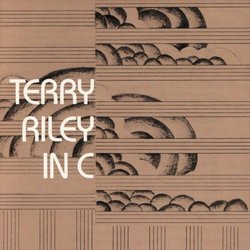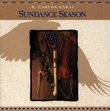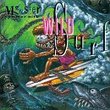| All Artists: Terry Riley, State University Center of Creative and Performing Arts Title: Terry Riley: In C Members Wishing: 6 Total Copies: 0 Label: Sony Release Date: 10/25/1990 Genres: Jazz, Classical Styles: Chamber Music, Historical Periods, Modern, 20th, & 21st Century Number of Discs: 1 SwapaCD Credits: 1 Other Editions: Terry Riley: In C; Liang: Music of a Thousand Springs; Zen (Ch'an) of Water UPCs: 074640717826, 007464071782 |
Search - Terry Riley, State University Center of Creative and Performing Arts :: Terry Riley: In C
 | Terry Riley, State University Center of Creative and Performing Arts Terry Riley: In C Genres: Jazz, Classical Sometimes simplicity is the mother of invention, and with In C, Terry Riley composed nothing short of a classic. A cornerstone of minimalism, Riley's 1964 composition is little more than a loose guideline for musicians. Dr... more » |
Larger Image |
CD DetailsSynopsis
Amazon.com Sometimes simplicity is the mother of invention, and with In C, Terry Riley composed nothing short of a classic. A cornerstone of minimalism, Riley's 1964 composition is little more than a loose guideline for musicians. Driven by the repeated pulses of even octave eighth notes played on the top two C keys of the piano, each member of the ensemble runs through 53 simple phrases at a self-determined pace. Gradually, swarms of instruments find themselves playing in unison, always to be overtaken by the perfect pacing of the pulsing piano. The entire composition gradually moves from C to E to C to G and, when performed correctly, the effect is otherworldly. This recording from 1968 features Riley himself on saxophone and a small ensemble of musicians from the New Music Center in Buffalo, New York. Overdubs were employed to keep the flow going and the effect of all this repetition is nothing short of mesmerizing, albeit slightly clinical. An even jazzier recording of this composition exists, the 25th Anniversary Concert on New Albion. On that live recording, a larger ensemble of jazz and classical's elite (including members of Kronos and Rova) invigorate In C with a full sound and plenty of gusto. --Jason Verlinde Similar CDs
|
CD ReviewsHard to listen to rubidium84 | Ft. Calhoun, NE | 12/03/2002 (2 out of 5 stars) "So...it seems that this record, along with Henry Cow's "Western Culture", sparks a lot of controversy among the crowd at amazon. But unlike some of my fellow reviewers, I am actually going to DESCRIBE the music insted of argue about it.From the beginning you can tell that this recording has suffered from the ravages of age (either that or they're using a very cheap piano). That's really too bad, because this might have been a very good performance, were we only able to hear it better."In C" is a very hard piece to play, both mentally and physically. The subtle, ever-shifting patterns demand that you not "listen", to the music, but just play it in the background, "tuning in" from time to time. But I have a problem with Riley's instrumentation: he always uses way too many woodwinds and mallet percussion, making the piece sound like an indonesian gamelan orchestra. If you like the gamelan sound, then you won't have any problem with that, but if you find it somewhat annoying, then watch out.Instead of this album, I would recommend the superb version recently released by Bang on a Can. They eliminate the gamelan effect and almost all of the wind instruments, using mostly strings such as Double Bass, Mandolin, and Electric Guitar. Listen for Jon Hassel playing trumpet on this release (with the mouthpiece on, I presume), sixteen years before his collaboration with Eno on "Fourth World Possible Musics". Hmmm. Interesting." Very important minimalist work Jeffrey J.Park | Massachusetts, USA | 01/13/2008 (5 out of 5 stars) "The compositional approach of Terry Riley and his pioneering minimalist work In C had a measurable impact on late 1960s and early 1970s musicians that wished to fuse more experimental styles with rock music. In fact, the Swedish group International Harvester is a pretty good example of this, not to mention some of the music of 1970-period Soft Machine. Written in 1964 (Riley prepared a 53 figure score of sorts which is reproduced in the liner notes), In C is classified as an aleatoric composition; that is, the element of chance plays a significant role in determining what the musicians play. Based on what I have read, performances of In C can last from 15 minutes to two hours and the piece is intended for any number of performers; amateur and trained virtuoso alike. On this 1968 recording, Terry performs with ten individuals from the Center for Creative and Performing Arts at SUNY (Buffalo, New York) and the performance lasts for approximately 42 minutes. Instrumentation includes saxophone (played by Terry Riley), bassoon, clarinet, oboe, viola, flute, trumpet, trombone, vibraphone and marimbaphone. Central to the performance is a piano part referred to as the "pulse" which is provided by Margaret Hassell. As described in the liner notes, the "pulse" consists of even octave eighth notes played on the top two C notes of the piano, which can clearly be heard at the beginning of the piece. The ensemble plays in sync with this pulse. The composition itself consists of a dense and subtly changing ostinato network. That is, each performer repeats a single part that is gradually changed, which in turn cues the other performers to also subtly alter what they are playing. As can be imagined, this music takes a great deal of skill and a highly developed ability to listen to the other players. Really good performances can get fairly complex and consist of a writhing mass of ever-shifting ostinati. Although several versions of In C are floating around out there (ranging from one by Japanese psychedelic rock outfit Acid Mothers Temple In C to a version by Bang on a Can Terry Riley: In C), I have not listened to them - as such I can not gage the relative quality of this 1968 performance. Suffice it to say that the changes within this version of In C are subtle (yet exciting), and listening to the entire work requires great concentration and patience on the part of the listener. While it is difficult to remain still amidst the furious bustle of 21st century living, e.g. kids, work etc... (even for 45 minutes), I found that making the effort was worth it. This album is very highly recommended along with A Rainbow in Curved Air (1969). Other influential minimalist composers include Steve Reich, Philip Glass and Lamonte Young. " Still the Best Recording L. Zajicek | San Diego, CA | 12/29/2005 (5 out of 5 stars) "Minimalism has produced five masterpieces: Philip Glass' "Music in Twelve Parts" and "Einstein on the Beach," La Monte Young's "The Well-Tuned Piano" (good luck finding that one!), Steve Reich's "Music for 18 Musicians," and Terry Riley's "In C." Although there are several recordings of "In C", each with a different orchestration, this one is probably still the best recording after all is said and done. (I only wish Mr. Riley would make a much longer recording, AT LEAST two hours long.)"
|


